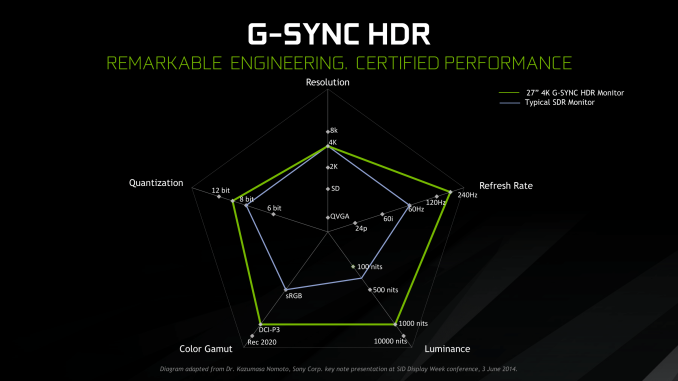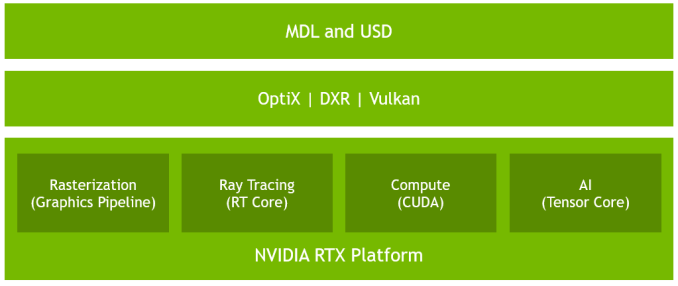The NVIDIA GeForce RTX 2080 Ti & RTX 2080 Founders Edition Review: Foundations For A Ray Traced Future
by Nate Oh on September 19, 2018 5:15 PM EST- Posted in
- GPUs
- Raytrace
- GeForce
- NVIDIA
- DirectX Raytracing
- Turing
- GeForce RTX
Meet The New Future of Gaming: Different Than The Old One
Up until last month, NVIDIA had been pushing a different, more conventional future for gaming and video cards, perhaps best exemplified by their recent launch of 27-in 4K G-Sync HDR monitors, courtesy of Asus and Acer. The specifications and display represented – and still represents – the aspired capabilities of PC gaming graphics: 4K resolution, 144 Hz refresh rate with G-Sync variable refresh, and high-quality HDR. The future was maxing out graphics settings on a game with high visual fidelity, enabling HDR, and rendering at 4K with triple-digit average framerate on a large screen. That target was not achievable by current performance, at least, certainly not by single-GPU cards. In the past, multi-GPU configurations were a stronger option provided that stuttering was not an issue, but recent years have seen both AMD and NVIDIA take a step back from CrossFireX and SLI, respectively.
Particularly with HDR, NVIDIA expressed a qualitative rather than quantitative enhancement in the gaming experience. Faster framerates and higher resolutions were more known quantities, easily demoed and with more intuitive benefits – though in the past there was the perception of 30fps as cinematic, and currently 1080p still remains stubbornly popular – where higher resolution means more possibility for details, higher even framerates meant smoother gameplay and video. Variable refresh rate technology soon followed, resolving the screen-tearing/V-Sync input lag dilemma, though again it took time to catch on to where it is now – nigh mandatory for a higher-end gaming monitor.
For gaming displays, HDR was substantively different than adding graphical details or allowing smoother gameplay and playback, because it meant a new dimension of ‘more possible colors’ and ‘brighter whites and darker blacks’ to gaming. Because HDR capability required support from the entire graphical chain, as well as high-quality HDR monitor and content to fully take advantage, it was harder to showcase. Added to the other aspects of high-end gaming graphics and pending the further development of VR, this was the future on the horizon for GPUs.
But today NVIDIA is switching gears, going to the fundamental way computer graphics are modelled in games today. Of the more realistic rendering processes, light can be emulated as rays that emit from their respective sources, but computing even a subset of the number of rays and their interactions (reflection, refraction, etc.) in a bounded space is so intensive that real time rendering was impossible. But to get the performance needed to render in real time, rasterization essentially boils down 3D objects as 2D representations to simplify the computations, significantly faking the behavior of light.
It’s on real time ray tracing that NVIDIA is staking its claim with GeForce RTX and Turing’s RT Cores. Covered more in-depth in our architecture article, NVIDIA’s real time ray tracing implementation takes all the shortcuts it can get, incorporating select real time ray tracing effects with significant denoising but keeping rasterization for everything else. Unfortunately, this hybrid rendering isn’t orthogonal to the previous concepts. Now, the ultimate experience would be hybrid rendered 4K with HDR support at high, steady, and variable framerates, though GPUs didn’t have enough performance to get to that point under traditional rasterization.
There’s a still a performance cost incurred with real time ray tracing effects, except right now only NVIDIA and developers have a clear idea of what it is. What we can say is that utilizing real time ray tracing effects in games may require sacrificing some or all three of high resolution, ultra high framerates, and HDR. HDR is limited by game support more than anything else. But the first two have arguably minimum performance standards when it comes to modern high-end gaming on PC – anything under 1080p is completely unpalatable, and anything under 30fps or more realistically 45 to 60fps hurts the playability. Variable refresh rate can mitigate the latter and framedrops are temporary, but low resolution is forever.
Ultimately, the real time ray tracing support needs to be implemented by developers via a supporting API like DXR – and many have been working hard on doing so – but currently there is no public timeline of application support for real time ray tracing, Tensor Core accelerated AI features, and Turing advanced shading. The list of games with support for Turing features - collectively called the RTX platform - will be available and updated on NVIDIA's site.













337 Comments
View All Comments
Qasar - Friday, September 21, 2018 - link
burntmybacon just like popinfresh, i guess you will never understand the concept of " no competition, we can charge what ever we want, and people will STILL buy it cause it is the only option if you want the best or fastest " it has NOTHING to do with knowing cost info or what a companies profit margins are... but i guess you will never understand this as welleva02langley - Thursday, September 20, 2018 - link
Once again, not AMD fault if Nvidia is trying to corner AMD with new hardware gimmicks like physix, and charging the customers.You never intended in buying an AMD card anyway, you just want a more affordable Nvidia solution. Guess what, pay for it or leave it.
Even by earning 100K a year, I refuse to pay the gimmick tax. I will buy Navi at release. Screw Nvidia.
V900 - Wednesday, September 19, 2018 - link
What a cool piece of technology!Raytracing would be amazing to have in games, and it really is the future of gaming. Its crazy to think there will be games with it already next year. (And some later this year!)
Is it too expensive? Meh, we are talking about TWENTY BILLION transistors squeezed into the area of a postage stamp.
People pay 600-1000$ for a phone, and some have no problem paying 1000$ for a CPU or a designer chair.
7-1200$ isn’t an unreasonable price for a cutting edge GPU that’s capable of raytracing and will be fast enough for the newest games for years to come.
imaheadcase - Wednesday, September 19, 2018 - link
Did that nvidia check cash they sent you to promote the items yet?shabby - Wednesday, September 19, 2018 - link
Definitely a shill, its too obvious.tamalero - Thursday, September 20, 2018 - link
Theres way too many here defending nvidia just because "its a huge chip".That means nothing for the consumer. We're not buying SIZE, we're buying PERFORMANCE AND FEATURES.
mapesdhs - Wednesday, September 26, 2018 - link
Some of the pro-RTX posts sound more like basic trolling though, just to stir things up. If they're getting paid to post +ve stuff, they're doing a pretty rotten job of it. :DformulaLS - Wednesday, September 19, 2018 - link
Your comments sounds like a paid ad. There is no decency excuse for the prices they are charging.DigitalFreak - Wednesday, September 19, 2018 - link
He has a point. People are willing to pay $1000 for a phone, $1000 for a CPU, but $1000 for a high end graphics card is outrageous? I wish the pricing was cheaper, but I'm not having a fit over it. If people don't want to pay the price, they won't. If Nvidia doesn't sell the numbers they want, they'll probably cut the price somewhat.Fritzkier - Wednesday, September 19, 2018 - link
The $1000 phone actually had more technological advancement... And it's an SoC not individual parts...About a $1000 CPU, it's normal because it's enthusiast product (e.g. Threadripper or i9). There's no $1000 i7 or Ryzen 7...
Nvidia shouldn't have made 2080 Ti. They should've made Titan Turing or something...